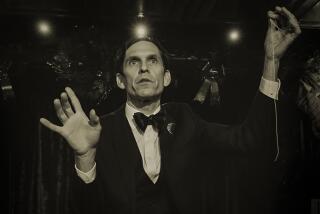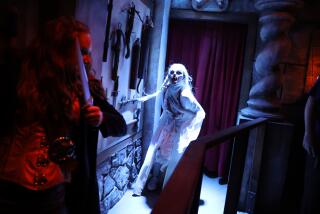Scary Business : Halloween: No longer relegated to neighborhood garages or vacant lots, high-tech haunted houses attract big profits that go to area charities.
No childhood is complete without its neighborhood haunted house. Whether an abandoned mansion or a failed condominium project, the decades of neglect surrounding such buildings are enough to bend the imagination in nightmarish directions.
Drawing on such childhood fears, haunted houses staged as fund-raisers have become big business in the San Fernando Valley. No longer makeshift affairs held in a neighborâs garage, the houses have grown into huge productions requiring blueprints, city permits, thousands of volunteer hours and standby emergency medical care.
The payoff arrives in proceeds that can total $250,000--in the case of the Factory of Nightmares run by the North Hills Jaycees. After a two-year absence, the Factory is back for its 15th year as spook central. This year it is being held at Burbankâs Media City Center mall.
Such houses cost up to $15,000 to operate and construct, using plywood, drywall and assorted costumes and props. Nearly 500 volunteers labored a month to construct the Factory. About 300 of them operate the house each night. Proceeds will be donated to the Jayceesâ favorite charities--the Cystic Fibrosis Foundation, Muscular Dystrophy Assn. and the March of Dimes--or to the recreation center sponsoring the event.
In past years, the Factory of Nightmares has drawn up to 36,000 people over its three-weekend run. This year, organizers hope at least 30,000 people will enter the six rooms connected by a maze of hallways that snake through 16,000 square feet at a new location, a former Buffums department store.
Other haunted houses in the area include ones run by the Simi Valley Jaycees and the Branford Recreation Center in Arleta.
Scare tactics have evolved considerably through the years. Forget the tired cherry Jell-O that doubles as squishy brains or the cooked spaghetti that runs through oneâs fingers like severed intestines. Todayâs haunted houses strive for surprise.
âNinety percent of a successful haunted house is good old-fashioned âBoo!â â said Matthew Ambrose, 29, who began as a Factory go-fer eight years ago and is now its âhead butcher.â
âWeâre not the movie studios. We canât turn people into wolves before their eyes,â he said.
Not that the Factory hasnât tried. In years past, Jaycee members have donated expensive camera and mirror equipment that transformed onlookers into skeletons and assorted monsters.
The Factoryâs butcher shop draws the most screams. âYou walk in and see people and body parts hanging up all over the place,â said Barry Eisenman, a North Hills Jaycee board member. âA guy in a white jacket talks about grinding up body parts. Then he grabs someone from the audience, throws them on the gut table and starts to cut them up, yanking out their intestines and stuff.â
Eisenman, 40, said the unfortunate victims are audience plants. But other board members add--with a wink--that the Factoryâs history is strewn with tragic mix-ups. âItâs possible weâll pull the wrong person out of the audience,â Ambrose said, lowering his voice. âBut we carry liability insurance.â
The Branford Recreation Center in Arleta stages a similar butcher shop tableau, called the Gore Room, in its haunted house fashioned from wood and plaster. âWe have a body cut off from the waist down--and the top half is a real person, alive and talking,â Branford director Doris Kingston said. âA surgeon removes his liver. Last year a Channel 9 anchorman did a live newscast dressed up as the cut-off body. They got some great ratings that night.â
Props for such scenes are usually obtained from local butcher shops. Large cow bones are effective as table decor and wieners easily double as severed fingers or a string of intestines.
âWe go to the grocery store for the liver,â said Kingston. âItâs a cow liver--you know, the ones they sell in those blue plastic cups.â
The Branford haunted house, called the Branbitybille Mansion, took 150 volunteers two weeks to construct on the centerâs tennis courts. A train resembling a steam engine, on loan from Griffith Park, transports arrivals from the park office to the five-room mansion. Assorted monsters join in the five-minute ride, which enters a swamp inhabited by a swamp creature.
Talking trees surround a graveyard that features a pounding heartbeat resounding through one grave site. âYou can bend down and feel it pulsating,â Kingston said, adding that the center has held the event for eight years. The house raised nearly $4,000 last year with total attendance of 1,000 during its four-night run.
The Simi Valley Jaycees created Terror Manor last year after hearing of other successful houses. The group raised $24,000 with a three-weekend attendance of 11,000. Attendance this year is targeted at 20,000, which should double proceeds to about $50,000.
Terror Manor II: the Halls of Doom is spread among two unrented retail stores totaling 5,700 square feet in Simi Valleyâs Mountain Gate Plaza. Malls usually donate space for the events.
A maze of hallways, a cemetery and a mausoleum are featured in the house, which took 40 volunteers three weeks to construct. Perhaps the most frightening aspect of such houses are the dimly lit hallways âwhere anything can happen,â Simi Valley Jaycees President Randy Greene said.
âDark, scary corners spook people the most,â said Greene, 24. âWhen you start out down a hallway and have to get to the end, itâs the anticipation of being scared along the way thatâs the most satisfying. Itâs like you have screams all bundled up inside of you. All you need is a little âBoo!â and those screams come flying out.â
Eisenman, of the Factory, calls them âhallway scares.â âWe have monsters waiting for people in hallways,â Eisenman said. âThey come down on them from above, from the right and from the left. But we never touch anybody--thatâs our policy. We want people to know that theyâre safe.â The Factory also uses a tennis ball machine that lobs balls toward passersby.
Fright and injury caused by flying tennis balls, strobe lights and severed body parts are the stuff lawsuits are made of, but none of the houses have been sued. Each haunted house posts and announces a disclaimer, warning pregnant women, epileptics, those who wear pacemakers and those who are generally squeamish to turn back. All houses carry liability insurance and most discourage children under 7 from entering.
âWe sometimes invite parents to go through first if they feel their kids canât handle it,â said Tom Williams, past president of the North Hills Jaycees. âWe havenât gotten any complaints--the house is really geared for mid-teens and above.â
The Factory reports five injuries through the years, the most severe being a fractured leg, which event insurance covered. Neighbors complained that the event drew gang activity in 1985 and 1986 and that traffic has usually been hard to navigate, although barricades have helped to clear residential streets.
The Factory began in 1975 at the Lemon Tree Bazaar, a strip of shops in San Fernando. Alice Cooper put in an appearance the first year, pushing his new record, âWelcome to My Nightmare.â Cooper drew 8,000 fans, but the largest single-night attendance occurred in 1986 when Halloween fell on a Friday night, luring 10,000 people.
In 1976, the Factory moved to an empty building in Devonshire Downs on Cal State Northridgeâs north campus. Because of impending development here, the event moved to Pierce College in 1987. It was last held in Lake View Terrace near Hansen Dam in 1988.
The real nightmares behind haunted houses are often logistic in nature. âThe behind-the-scenes planning with this type of project is mind-boggling,â Ambrose said. âBut everyone ends up learning great lessons in leadership and cooperation.â
In most areas, blueprints must be approved by the city planning office and permits from the fire marshal and police department are required before construction begins. Corporate sponsors, such as A&W; Root Beer, which donated 72 15-second radio spots for the Factory, help advertise the events.
âThe Factory of Nightmares has always been operated in a very professional manner,â said Bob Kovac, operations manager for California Emergency Medical Patrol, a mobile first aid unit that donates its time and equipment to staff a van at the Factory site.
The Factory recruits many of its volunteers from Burbank, Kennedy, Granada Hills and Chatsworth high schools. Chairpersons coordinate the troupes of actors needed for each room. Volunteers are shuffled between three trailers for makeup and wardrobe.
A âsecurity holeâ is in the center of the Factoryâs maze. The 30- by 90-foot space is stocked with fire extinguishers, security personnel and computers that control sound and light displays. Doors from each room of the house feed into the area, should any participant need a reality check.
Traffic flow within the house is constantly monitored. Should bottlenecks occur, the right hallway scare can often clear an area.
âSometimes we need to get a slow crowd moving,â Eisenman said. âWe have someone dressed up in rags who follows behind a group in a hallway. If theyâre dawdling, he starts up a chain saw heâs carrying--donât worry, weâve removed the chain. People tend to pay attention to that. It empties a hallway like nothing else.â
Foster writes regularly for The Times.
More to Read
Sign up for Essential California
The most important California stories and recommendations in your inbox every morning.
You may occasionally receive promotional content from the Los Angeles Times.










